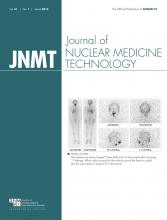
Norman E. Bolus, MSPH, MPH, CNMT, FSNMMI-TS
I have just returned from the SNMMI 2013 mid-winter meeting in New Orleans, Louisiana, and I find myself once again amazed at the staying power of our profession. Despite many issues facing our profession, we seem always able to find a niche for what we do. The unique ability of nuclear medicine to see the body in both a functional and an anatomic manner—rather than just anatomic—has, since our beginning, given us an edge over other diagnostic imaging modalities. This is even more evident as, with the joining of modern modalities such as PET with MR imaging as PET/MR imaging and PET with CT as PET/CT or even SPECT with CT as SPECT/CT, we continue to play a role in diagnosis and treatment planning for patients. There are challenges ahead, and SNMMI is helping to advocate for our profession in many different ways. Advocacy is an important job the Society does for us, and by being members we are helping in these efforts. At every national meeting, NCOR meets in a governance session before the main meeting. This is an opportunity to attend to the business of SNMMI-TS and provide a platform for any issues that need to be addressed by SNMMI and SNMMI-TS. During the last couple of years, part of the NCOR meeting has resulted in special, focused breakout sessions on pertinent topics that are of concern or need further investigation by SNMMI. This year at the mid-winter meeting the breakout groups discussed regulations and reimbursement, membership and leadership development, education, and the job market. Although these sessions are not designed to solve the issues, they do open a dialogue for discussion and emphasize what SNMMI views to be important topics going forward. All of these concern some issue that needs to be addressed, and the idea is that some sort of response to these issues will be put forth because they need special attention at this time. The meeting program consisted of many interesting topics organized by Kathleen Krisak, program chair, including improving PET imaging in clinical research; coding and reimbursement; PET imaging sensitivity in oncology; cardiac imaging—past, present, and future; and new PET pharmaceuticals in brain imaging.
On the horizon is the SNMMI 2013 annual meeting scheduled for June 8–12, 2013, in Vancouver, British Columbia, Canada. The online meeting planner and registration information is already available on the SNMMI Web site. Early-bird registration is open until April 11, 2013. This promises to be another great meeting with many and varied topics as part of the program. It was noted at the mid-winter meeting that the number of abstracts submitted to the Vancouver meeting is the second largest ever received by SNMMI for an annual meeting. This number of submissions lends oneself to recognize the ongoing research in our field and the fact that research is not stagnant or declining but increasing. Research is important if our field is to succeed in continuing to find a niche as we move forward. Other important topics to which we should be paying attention are appropriate-use criteria, dose reduction techniques, and translational research.“More than any other specialty, nuclear medicine brought together structure and function, which accounts for the wide acceptance today of combined structural, functional, and biochemical imaging in medicine and biomedical research.”
—the late Henry N. Wagner, Jr., MD, circa 2006
In this issue of JNMT there are a number of case reports ranging from 90Y radioembolization, a 131I false-positive scalp study, the role of correlative imaging in the diagnosis of primary hyperthyroidism–related brown tumors, hormone therapy in prostate cancer, and brain SPECT imaging with acetazolamide challenge. There is an invited commentary on theranostics from a student perspective, along with articles on imaging and radiopharmaceutical research. There are also 2 book reviews and an original continuing education (CE) article by Kristi Mitchell and Susan Bunning on the impact of issues concerning health-care reform on nuclear medicine. The other CE article is a reprint of a JNM article on amyloid brain imaging that first appeared in November 2011. Since this is a reprint article, if you received CE credit previously for this article you cannot receive credit twice for the same article. I am still in need of authors for JNMT CE articles. If you have a topic on which you would like to write, please let me or Kristen Waterstram-Rich (CE editor for JNMT) know. There is a small honorarium for accepted CE articles. These articles are peer-reviewed, as are all articles and case reports in JNMT.
Also, in an effort to encourage feedback, go online (www.snm.org/facebook) and join a discussion that I will begin on a situational judgment concerning a pregnant patient and nuclear cardiology: “Oh My! The Patient We Had Yesterday—Who Said She Was Not Pregnant—Is. Now What?”







